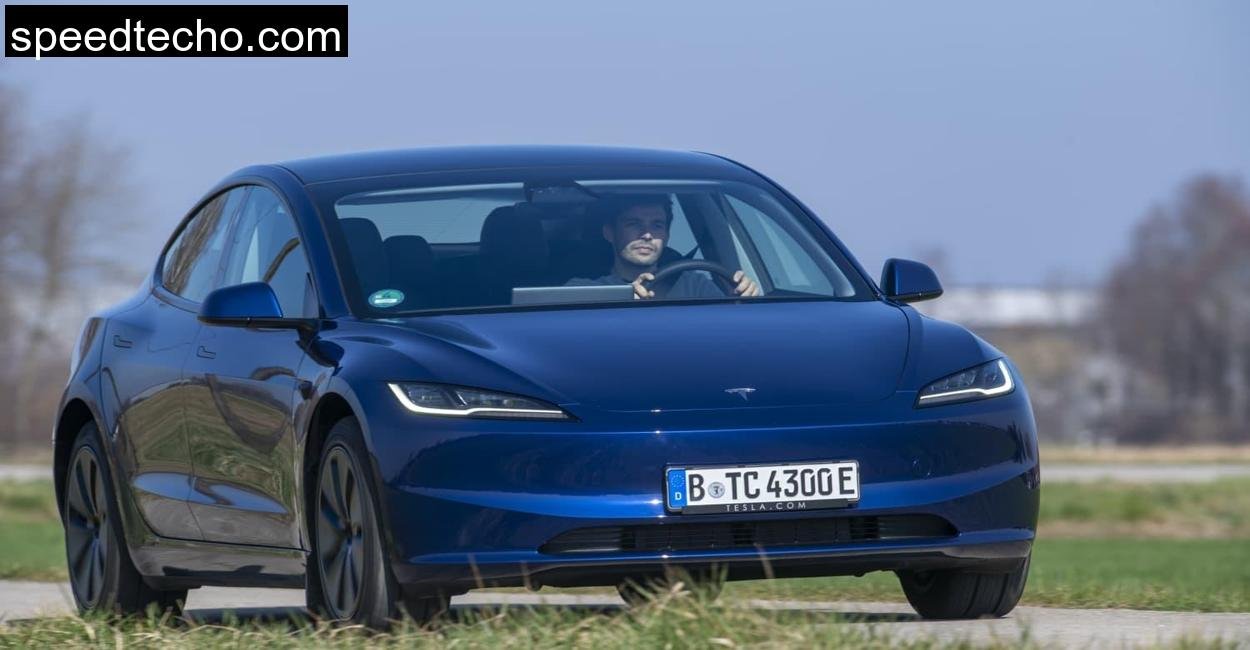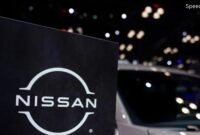The Tesla Model 3 Highland: A Smoother Weapon
You’ll notice it even before your hands reach the flush door handles: The Highland is sharper, sleeker, and more cohesive than the outgoing model. The front fascia has been cleaned up and narrowed, with a new light signature that now makes the Model 3 look like it belongs in 2025. Tesla didn’t just smoothen the body, they fine, tuned the aerodynamics. The result is less drag, more range, and better efficiency, especially at autobahn speeds.
But here’s where it really started to impress: riding through Melle’s sweeping countryside curves and rough village cobbles, I could immediately feel a calmer ride. The Highland’s suspension setup, still passive dampers, has been recalibrated. It doesn’t crash over ridges or chatter through potholes anymore. No, it glides, relatively speaking. The old “Tesla bounce” is mostly gone.
No adaptive suspension, no magic body control, and yet I found myself enjoying every dip and crest. It was responsive without being fidgety, composed without becoming sterile. The NVH improvements are especially notable. Thanks to laminated acoustic glass all around and additional cabin padding, the Model 3 Highland is whisper, quiet even at 130 km/h. On the Melle ring road, it was as hushed as a luxury ICE cruiser.
Two Faces: Rear, Wheel vs All, Wheel Drive
I tested both versions of the facelifted Model 3: the Standard Range rear, wheel drive and the Maximum Range dual, motor all, wheel drive. The difference is night and day, even though they wear the same skin.
The Standard Range, now with 208 kW (283 hp), is a joy for smooth drivers. The torque curve feels natural, linear, and still blisteringly fast. You go from 0 to 100 km/h in just over 6 seconds, and there’s absolutely zero lag. It’s not explosive, but in corners above Melle’s Kalkriese pass, the rear, wheel, drive layout gave the car a beautiful balance. No torque steer, just clean power transitions and that razor, sharp Tesla steering, only 2.2 turns lock, to, lock. It’s nimble like a much smaller car.
Now, the Maximum Range version is something else entirely. With 340 kW (460+ hp) and dual motors, this is straight, up rocket material. It squats, bites, and leaps forward with breathtaking violence. I nailed 100 km/h in 4.2 seconds and 60, 100 in 2.1 seconds. Merging into fast autobahn traffic? Blink and you’ve already passed the middle lane. The grip from the AWD system on damp tarmac was tenacious. Even pushing hard through sharp wet bends around Westerhausen, the car just stuck.
If the rear, wheel, drive Highland feels like a modern dancer, the dual, motor feels like a sprinter mid, race, fast, calculated, brutally efficient.

Highland’s Interior: Minimalist or Misdirection?
Step inside the Highland and you’re greeted with calm, a Scandinavian calm, really. The dash is cleaner now, devoid of stalks or knobs. The gear selector has been moved to the screen. The turn indicators? Gone from the stalk and now replaced with touch buttons on the steering wheel.
Honestly? At first, I was irritated.
Using those steering wheel buttons for signaling, especially when cornering in a roundabout or weaving through tight Melle village lanes, was unnatural. It felt like re, learning how to drive. You need to press hard and hit the exact button while turning. It’s too easy to miss, and in real, world conditions, it’s a safety concern. Sure, you adapt, but should you have to?
Aside from that ergonomic oddity, the interior refinement is stellar. The Alcantara, wrapped pillars, carpeted lower sections, and ambient lighting strip across the dash add a luxury feel I didn’t expect. The seats have been reshaped and now offer better bolstering and thigh support. My 2, hour drive through Teutoburg’s dense traffic and open roads left me fresh and ache, free.
Rear passengers get their own display now, small, sure, but functional. Streaming Netflix while charging near the Teutoburger Wald Tesla Supercharger felt like a preview of automotive lounging in the future.
Real, World Range and Charging: Still the Benchmark
Tesla’s bragging rights still start and end with range and charging performance. And the Highland only extends the lead.
On the ADAC cycle, the Standard Range version used 17.2 kWh/100 km, which matched closely with my real, world result through Melle’s variable terrain: 16.9 to 18.0 kWh/100 km, depending on speed and climate control. That gave me around 390 to 410 km of usable range. With the dual, motor version, I saw 18.7 kWh/100 km and a range of around 470 km, stellar, given its performance edge.
The real winner? Charging. I rolled into a Tesla V3 Supercharger near Bissendorf with 12% left, and within 31 minutes, I had 80% again. No card, no app. Just plug and go. It feels like refueling should feel in the EV world.
And the battery preheats if you navigate to a Supercharger, which ensures optimal speeds every time. No fiddling. No waiting.
Practicality: Enough for Daily Life
Let’s not forget what the Model 3 is underneath all this tech sheen: a mid, size family sedan. And here, the Highland makes a solid case.
Rear passengers up to 1.90m have space, though headroom in the back is a bit tight due to the sloping roof. The 415, liter boot is wide and usable, expandable to 825 liters with seats folded. There’s a clever frunk, too, perfect for cables or even a weekend bag.
I transported my folding bike by dropping the rear seats and angling the front wheel diagonally. No stress. There’s also a new under, floor storage compartment in the boot, good for chargers or muddy shoes post, hike in Melle.
Visibility out the rear remains poor, though. Without the high, resolution reversing camera, backing into narrow farm lanes would’ve been guesswork.

Tesla’s Autopilot: Still Not There
I’ll say it straight: Tesla’s semi, autonomous features remain frustrating. The lane assist is twitchy on rural roads, the adaptive cruise control brakes randomly, and without ultrasonic sensors, parking assistance is limited. In daylight, it’s okay. In dim light or rain? Forget about trusting it.
You can pay €3,800 for Enhanced Autopilot or €7,500 for Full Self, Driving (FSD), but for now, both are software hopefuls without legal or practical teeth in Europe.
If you buy a Model 3, buy it for you to drive, not for the car to drive you.

Conclusion: Worth the Wait, With a Few Caveats
After hundreds of kilometers through the Melle Hills’ wild variety, stone paths, autobahn sprints, and quiet village loops, the Tesla Model 3 Highland has proved itself as more than just a facelift. It’s a refinement, a course correction, and in many ways, a maturing moment for the brand.
The comfort is better. The design is sleeker. The real, world range is unbeatable. But Tesla’s obsession with stripping controls to the bone has gone too far in places, particularly the signal stalk deletion. You adapt, but do you want to?
Still, if you’re buying with your head, heart, and a wallbox in your garage, the Highland is now not just the smart EV, it’s finally the enjoyable one too.
How does the Model 3 Highland’s range compare to its predecessor?
he Highland offers improved range, with the Long Range AWD variant achieving up to 629 km WLTP, compared to the previous model’s lower range figures.
Are the new touch, sensitive controls user friendly in Tesla Model 3?
While they contribute to the minimalist design, some drivers may find them less intuitive than traditional stalks, especially during dynamic driving.
Does the Model 3 Highland support fast charging?
Yes, it supports DC fast charging, adding up to 282 km of range in approximately 15 minutes using Tesla’s Supercharger network.






